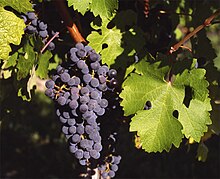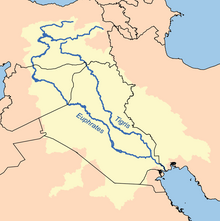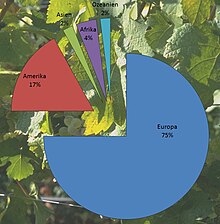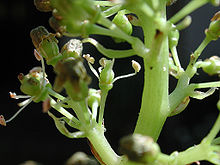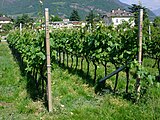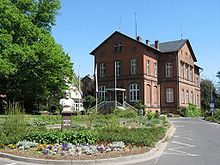Viticulture
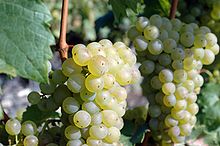
Viticulture , wine and viticulture (Switzerland) are in wine-growing areas used interchangeably. The terms denote the cultivation (also the science) of vines for the purpose of obtaining grapes in order to produce wine . The viticulture is carried out by the winemaker (also known as winemaker , winemaker or wine grower ). The production of the wine takes place in the cellar (wineries, wineries). All work and facilities that are required for the production of the wine are handled in the cellar economy. It is also known as oenology .
Viticulture includes the history, distribution and economic importance of the vine, the organs of the vine, the grape varieties and vine breeding, vine propagation, new planting, planting, care measures (pruning, education, soil care and fertilization) and plant protection (beneficial insects, diseases, pests, Other damage), production methods in viticulture, training opportunities.
history
The vast areas south of the Caspian Sea and the intermediate current lands ( Euphrates , Tigris ) to the Persian Gulf are considered to be the centers of origin of the grapevine (cultivated grapevine - Vitis vinifera) and viticulture. As early as 5000 BC Chr. Can be in the South Caucasus (now Georgia ), as well as in the Near Eastern landscape Sumer (now southern Iraq ) for the first time, the cultivation of vines detected by human hands. Viticulture spread from there throughout the Middle East , and around 1700 BC. The Minoan noble vines cultivated on Crete . Greek colonists are likely in the 7th / 6th Century BC First brought vines to Gaul (Massalia → Marseille).
Distribution and importance
The vine has certain climatic requirements and thrives in the temperate climate zone. In the northern hemisphere, the cultivation zone lies between the 30th (20 ° C isotherm) and 50th degree of latitude (10 ° C isotherm). In the southern hemisphere, the cultivation zone is between the 30th and 40th parallel. Vines thrive from very hot ( Southern California ) to cool ( England , Luxembourg ), from very humid to very dry growing areas ( Central Valley in California). Vines are cultivated on steep slopes ( Moselle valley , Wachau , Douro valley , Ahr valley , Ruwer ) and on flat surfaces. The cultivation is very different in the different areas (manual labor, use of machines). The planting density also varies from 10,000 vines / ha ( Bordeaux , Champagne ) to 600 vines / ha ( Vinho Verde region in Portugal).
Viticulture is one of the oldest specialized agricultural cultures. The cultivation of the vine shapes the landscape and the economy of entire areas. Conversely, the landscape, the soil with its minerality and the climatic conditions are reflected in the wine, which the French use the broad term " terroir " to describe the site conditions. Today we reflect on nature and the natural foundations of life, but also on tradition, and so the wine-growing areas as recreational areas and the company as a place of work are becoming increasingly important. In the last three decades, the global wine-growing area has changed significantly. From the 20th century onwards, there was a massive intensification of wine-growing in the "new wine-growing countries" (California, South Africa, South America, Australia and New Zealand), while declines in the classic wine-growing countries (Europe, the Caucasus and the Mediterranean) are contrasted.
World vineyard development
In the introduction to a report by the International Organization of Vine and Wine (OIV) it says:
“After the strong growth up to the end of the 1970s, the area under vines around the world declined due to the European Union (EU) funding measures for clearing and the massive clearing in the former USSR. This decline continued until 1998, albeit to a lesser extent. At this point in time, the worldwide vineyards reached 7.6 Mha, their lowest level since 1950. After that, there was an increase in the period 1998–2002 that can even be classified as rapid up to 2000 (annual growth of over 1.4%) and the vineyards reached 7.9 Mha. The results recorded in 2007 suggest that, after these years of upswing, there is again a decline in global vineyards. Reasons for the development observed after 2003:
- The balance of plantings and clearings is still positive overall in the countries of the southern hemisphere and in the United States (USA): (approx. +50 tha between 2003 and 2007 compared to +170 tha between 1998 and 2002).
- Despite the restriction of the scope of application of the Community regulation for the financing of the final abandonment of vineyards (from the 1996/97 marketing year) and the reintroduction of new planting rights from 1999, the European vineyards (including the CEEC and the former USSR) are declining again, leading to a decrease in vineyards of 170 tha between 2003 and 2007 leads.
- The significantly slower growth of the Chinese vineyards (approx. +18 tha between 2003 and 2007 compared to approx. +227 tha between 1998 and 2002) is responsible for the decline in the Turkish vineyard area (of the order of −49 tha between 2003 and 2007 compared to −12 tha between 1998 and 2002) cannot be caught. Despite the presumed increase in vineyards in Iran, the decline in Asian vineyards in the period 2003-2007 will be around 20 tha.
- Thus, the worldwide vineyards in 2007 totaled 7,792 tha, i.e. H. the total area is between that of 1999 (7 726 tha) and that of 2000 (7 854 tha). Expressed in absolute terms, this decrease compared to 2006 is rather clear (-26 Tha), but limited in percentage value: -0.3%. Compared to 2003, the decrease amounts to a total of 124 tha, which results in an average annual decrease of 31 tha (compared to the average annual growth for the period 1998-2002 of 66 tha). "
The OIV report "Statistical report on world vitiviniculture 2013" provides extensive statistics on the development of the wine-growing area and the world wine industry. These are the following notifications:
- Wine-growing areas of the countries of the world in 2018. Situation and statistics of viticulture worldwide
- Press release of the OIV about the worldwide situation of viticulture
- the world wine statistics
| Producing country |
Cultivation area (1000 ha ) |
proportion of | Pro duk- tion (million hl ) |
|---|---|---|---|
|
|
969 | 13% | 44.4 |
|
|
875 | 12% | 9.1 |
|
|
793 | 11% | 48.6 |
|
|
705 | 9% | 54.8 |
|
|
448 | 6% | k. A. |
|
|
439 | <5% | 23.9 |
|
|
218 | <5% | 14.5 |
|
|
212 | <5% | 12.9 |
|
|
192 | <5% | 6.1 |
|
|
191 | <5% | 5.1 |
|
|
153 | <5% | k. A. |
|
|
151 | <5% | k. A. |
|
|
147 | <5% | 1.9 |
|
|
146 | <5% | 12.9 |
|
|
126 | <5% | 9.5 |
|
|
111 | <5% | k. A. |
|
|
106 | <5% | 2.2 |
|
|
103 | <5% | 10.3 |
According to the 2019 vineyard statistics from the Federal Statistical Office, 67% of the vineyards in Germany were planted with white grapes, 33% with red grapes.
Economical meaning
The millennia-old tradition of viticulture has meant that viticulture and wine are a part of the way of life for the population of an area and belong to it. Wine culture has always been an expression of joie de vivre and culture. Relationships between vines and wine on the one hand, landscape and human culture on the other hand are diverse and have influenced one another. Fine arts, poetry, customs and religion have honored and extolled vine and wine at all times. Wine embodies a piece of occidental cultural history. Viticulture is one of the oldest cultures. The vineyards shape the landscape and the economy of entire countries and provide the basis for tourist use.
In the last 2000 years, viticulture has also been shaped by the very changeable economic development. The Romans tried to influence production very early on. Domitian gave the order to clear half of the vineyards in the Roman Empire outside Italy in order to counteract the decline in the Italian wine price. With the beginning of the industrial age, viticulture in Europe suffered enormous economic damage due to the introduction of phylloxera and the fungal diseases downy mildew and oidium ( powdery mildew ). Only after the end of the Second World War did the entire world economy recover, and with it viticulture.
Mechanization made grape production easier and cheaper, and many scientific findings led to the use of various agrochemicals. This not only led to an increase in quality, but also secured production. The world's highest wine consumption was between 1976 and 1980 during a period of great global economic expansion. Production sank until 1990 and then increased again. In Europe in particular, however, the surplus of wine increased significantly. The main reason for the decline in consumption and the increasing surplus was the decline in per capita consumption in the main wine producing countries of France and Italy. Very high grape harvests in 1982 and 1983 added theirs.
Europe has about 2/3 of the world viticulture area. Asian and North African countries also have considerable vineyards, but for religious and cultural reasons, wine production is much less important there. The focus there is on the production of raisins and table grapes . The consumption of wine in the countries of the world is very different. Wine is mainly important in the countries of the Christian-European culture area. Per capita consumption depends heavily on the income of the population. Wine is traditionally part of everyday life, especially in Mediterranean countries. There has been a decline in wine consumption since the 1960s. Despite the increase in consumption in other industrialized countries in Northern and Western Europe as well as North America, Japan and other Asian countries, the global decline in consumption could not be compensated, so that there was a decline in the global area under vines.
Wine-growing areas
A wine-growing area (Weinbauflur ( AT ), Rebbauzone ( CH )) is a geographical region in which wine with the name of the wine-growing area may be grown. As a rule, wine-growing areas have grown historically because in certain regions of a country vines thrive and good grape quality can be regularly produced and not in others (insufficient grape ripeness, frequent winter or late frost risk, etc.). Today they are legally defined areas (with precisely regulated designation) in most countries. These areas and their locations are suitable for the climate, the location and the soil conditions to enable the vine to develop well. All areas planted with vines are to be kept in a viticulture cadastre . The regulation for the keeping of a viticulture register does not exist in all viticulture countries in the world.
vine
The vine is one of the oldest cultivated plants. With increasing systematic use, cultivated vines have emerged from the wild vines through human use and natural crossings (random crossings). Cultivated vines are selected ( mutation , natural crossing ) descendants of the wild grape, which were specifically cultivated starting in the 18th century. It is estimated that there are around 10,000 to 25,000 grape varieties worldwide today. But only a small proportion of this is of economic importance.
Botanically, the grapevine belongs to the order of the buckthorn family (Rhamnales). One family of these are the grapevines (Vitaceae). The genus Vitis is distributed all over the world in various wild forms. There are two sub-genera, of which the sub-genus Euvitis supplies the vine material for wine-growing. North America currently has most of the known, naturally occurring species.
Organs of the vine
For the practical implementation of care measures, the function and structure of the organs of the vine are prerequisites for correct care.
The above-ground organs of the vine with trunk of old wood and a year of wood, from the buds (eyes) sprouts the engine - it sprout , leaf (Plant) , water laps , Geschein , Rebblüte , Ranke , shoot tip , because grape and grape . The underground organs of the vine are the roots .
Grape varieties
Around 16,800 varieties are currently registered in the European Vitis Database (12,431 Vitis vinifera L., 3,949 Vitis Interspecific Crossing , 529 other Vitis species). It can be assumed that several thousand varieties are still available worldwide, but have not yet been entered into the database.
The ampelography even Ampelografie, German grape varieties or Oenology is the doctrine of the determination and description of varieties and their scientific classification.
The high number of grape varieties is the result of mutation, natural selection and crossing. As long as man has been cultivating vines, he has selected and made targeted crossings for over 150 years. The properties of grape varieties are not stable in the long term (even with vegetative propagation) - they are subject to natural influences (radiation, location influences, degradation diseases), which slowly changes positive and negative properties.
Vine breeding
Vines are evaluated according to certain criteria through selection / selection ( selection breeding ) and only those vines that meet the requirements are propagated. With the cross-breeding new varieties emerge with new properties (variety). Since breeding work takes many years to control a variety and its properties, this work is mostly done in viticulture institutes. Under new breed means a new gained vine plant, which was produced with a particular breeding method. The recognition of newly bred varieties (for plant breeding ) is regulated by law in the Plant Variety Protection Act and is administered by the Federal Plant Variety Office (for Germany).
State breeding and research institutes
Deal with grapevine breeding in
Germany
- Institute for Grapevine Breeding Geilweilerhof , Siebeldingen
- State Viticulture Institute Freiburg , Freiburg im Breisgau
- State teaching and research institute for viticulture and fruit growing , Weinsberg
- Department of grapevine breeding and refinement of the Geisenheim research institute , Geisenheim
- Bavarian State Institute for Viticulture and Horticulture with a technical and technical school for horticulture, gardening and landscaping, viticulture and cellar management in Veitshöchheim
- State Institute for Vine Breeding , Alzey (dissolved in 2005)
Austria
Switzerland
- Research Institute Agroscope Changins-Wädenswil ACW
Plant variety protection
Vine propagation

The vines can propagate in two ways: sexually (generatively) and asexually (vegetatively). Generative propagation with seeds is only important in cross-breeding. For practical viticulture, only asexual (vegetative) propagation plays a role. This type of propagation takes place in the form of cuttings and offshoots. The processing (connection of rootstock and noble rice with subsequent shoot formation and root development as with a cutting) is of particular importance.
- Vine seedlings
- Vine nursery
Planting a vineyard
The establishment of a successful and profitable system that guarantees the location-adapted yields with high quality and a service life of 25 to 30 years can only be achieved through the interaction of a number of factors, the location factors (climate, soil, location).
Location requirements of the vine
The vine places high demands on the location. Both the soil , the location and the climate are very crucial for success. The location factors and all maintenance measures are always to be seen as an overall system with its interactions. In France, the term terroir is used for this . Terroir literally means something like soil, origin, home. In viticulture, the complex interplay of geological raw material, topography (location), climate and soil is meant.
The consequences of global warming for viticulture should be taken into account particularly when choosing the variety and rootstock, the planned education system and soil maintenance (irrigation). Due to climate change, the limits of viticulture are shifting.
Maintenance measures
A vineyard requires a number of care measures such as pruning , education , foliage work, grape thinning, soil care and organic (humus fertilizer) and mineral fertilizers (mineral commercial fertilizers) adapted to the vine (and soil).
Pruning
Pruning refers to the annual pruning of annual wood and corrections to the old wood. The necessary work is carried out during the dormancy period (winter pruning). In principle, the annual pruning is not necessary from the point of view of plant physiology. Most educational systems, however, require cutting back. The annual cut changes the development of shoots, leaves and grapes. Root formation is also reduced the fewer shoots the vine develops.
Upbringing the vine

The vine is a climbing plant and needs constant support. Education means the structure and shape of a vine. The vintner gives the vine a characteristic frame (old wood) depending on the type of upbringing. The task of education is to ensure quality and quantity and to create economic advantages (use of machines).
Classification
The vine training systems can be divided according to different aspects. The name of the education is different in the wine-growing areas or countries. Often they are named after people ( Lenz Moser , Jules Guyot , Scott, Henry, etc.) or areas. Many systems are similar in the structural system. The difference usually results from the characteristics of a variety, the possible or desired degree of mechanization and also economic conditions. Wire frame support was previously not possible. For example, the vines used to be grown on trees, braided wood shoots, stakes ( pole training, stick culture ) or a wooden framework ( pergler training ) or provided with them.
Educational systems
The vertical vine training systems have the greatest importance and distribution .
Schematic representation of the espalier education.
Support materials
Support materials should have a long service life, good stability and (especially if mechanical grape harvesting is planned) elasticity. Light weight is important for the creation. They should be inexpensive and require little maintenance. They should not pollute the soil or groundwater and should be easy to dispose of.
For support you need:
- Insert (planting stakes, seed rods) made of metal, wood, fiberglass or plastic as a support for the young vine and the later strain
- Uprights (columns, Bagstall, Stickelberger ) of metal, wood or concrete, as the carrier of the wire frame
- Wire made of metal, plastic as a climbing and looping aid for the green shoots, e.g. B. by means of wire frame support or wire hook
- Fixing material for annual and perennial wood after pruning
- Anchors for anchoring the end posts, e.g. B. Rod anchor
Canopy work
Canopy work supplements pruning during the vegetation period in order to fully utilize the productivity of the canopy, i.e. the production of assimilates ( photosynthesis ).
- Weeding (breaking out of shoots)
- Thinning out the grape zone
- Knitting (looping the shoots)
- Stripping of the shoots - peaks (tops)
- Ausgeizen (removal of suckers )
Yield regulation
Under the yield regulation (revenue management) refers to all management measures that influence the level of income. The level of yield has the greatest influence on the quality of the grapes and thus on the quality of the wine. Yield regulation was not an issue in practice until the 1980s. With increasing quality requirements, however, this measure is undisputed today, as the wine quality is influenced to a great extent.
There are a number of possibilities and effects of income control measures that are accepted and practiced in practice. Yield-controlling measures to be carried out manually, such as weak pruning, clipping, dividing or stripping off bills, stripping off grapes, dividing grapes, cutting off grapes (grape thinning) or mechanically with leaf-removing, grape harvesting (green harvest), grape brush or chemically with bio-regulators (note approval), require a sensible selection that is adapted to the given annual yield level, the annual weather pattern, the variety, the desired level of quality and the available workforce.
Floor care
Floor care means the use of different floor care systems that influence the biological, chemical and physical properties of the floor. Depending on the measure, it can have a positive or negative effect. Maintenance measures that have negative long-term effects are to be avoided.
Nutrition and fertilization of the vine
The soil maintenance measures are to be seen together with the nutrition and fertilization, as there are many interactions with them. Fertilization means not only a supply of nutrients, but also the mobilization of the nutrients bound in the soil. The nutrient supply of the soil from the natural replenishment (mineral particles, humus content) is not sufficient in the long term due to the regular withdrawal of nutrients . By fertilizing with organic and mineral fertilizers, organically bound and mineral (inorganic) nutrients are supplied to the vines above the soil.
Vine nutrition, soil analysis, interpretation of soil analysis, fertilization and fertilizer effects, fertilizers and information on leaf analysis are contained in the Austrian brochure Guidelines for Appropriate Fertilization in Viticulture .
irrigation
Like any plant, vines also need water as a solvent, a means of transporting nutrients and assimilates, swelling agents, nutrients and temperature regulators. In wine-growing areas with little precipitation and on locations with soils rich in skeletons , an additional water supply serves to ensure quality, wood maturity and the quantity yield.
Plant protection in viticulture
The plant protection covers all the efforts, damage and reduction of crops by exploiting prevent all relevant scientific findings in an ecologically and economically reasonable manner or mitigate.
With various control and limitation methods, the vine is protected from damage, taking into account environmental compatibility and economic efficiency as well as other effects. The emergence of harmful organisms as a result of disturbances of the ecological balance and insufficient resistance of the vine is prevented.
Plant protection measures

- Cultivation measures: soil care, fertilization, pruning and upbringing, foliage work, grape thinning
- Mechanical-physical measures: Use of protective covers against game bites, frost protection, hail nets, protection against "harmful birds" by means of bird protection nets or optical and acoustic deterrent measures
- Biological processes - biological plant protection: Use of beneficial organisms to regulate plant diseases and pests, use of insect pathogenic ( insecticidal ) bacteria ( Bacillus thuring iensis) and the use of natural regulatory mechanisms through the protection, promotion or naturalization of beneficial insects ( the predatory mite Typhlodromus pyri is of particular importance to regulate harmful mites).
- Biotechnical processes: warning screams, noise, repellents , pheromones , rootstocks to protect against the damage caused by phylloxera, use of resistant grape varieties
- Chemical processes: targeted use of approved plant protection products
- Plant quarantine (import control)
Depending on the procedure, a distinction is made between integrated and conventional plant protection:
Integrated crop protection
This is a procedure in which all economically, ecologically and toxicologically acceptable methods are used to keep the extent of damage below the economic damage threshold. It is a combination of all plant protection measures. This ensures high quality with sufficient yield; the agro-ecosystem and the environment are affected as little as possible.
Conventional crop protection
This refers to a procedure in the use of chemical pesticides, where pesticide measures are only carried out with regular preventive spraying, without controlling the development of diseases and pests and without taking into account the negative effects of pesticides on the ecosystem (rigid calendar routine spraying program). This almost blind procedure, with the aim of achieving the most total possible destruction of the harmful organisms, is no longer practiced today. Today there are almost only pesticides available that are suitable for integrated pest management and that meet the additional licensing requirements. In recent years, a large number of pesticides have been de-registered and all new pesticides coming onto the market mostly meet the requirements of integrated pest management .
Plant protection products are used in all viticultural production methods. Especially in organic viticulture have plants tonic meaning. These can also be used in all viticultural production methods.
Pesticides
Plant protection products contain chemical or biological active ingredients and preparations (formulations) that are intended to:
- To protect plants and plant products from harmful organisms or to prevent their effects,
- destroy unwanted plants ( weeds ) or parts of plants (stem shoots).
Pesticides are used in all viticultural production methods, including integrated viticulture , organic viticulture and biodynamic viticulture .
Information on this can be found in particular in the articles insecticide , fungicide , Bordeaux broth , acaricide , repellent .
Plant strengtheners
Application technology in viticulture
With the help of various application methods, plant protection agents and / or plant strengtheners are applied specifically to the parts of the plant to be protected. These are mainly today blower sprayers of various designs and blower technology used.
Pests
In the broadest sense, harmful pathogens are all harmful deviations from the normal course of the life process of the vine. It can be caused by fungi, bacteria, viruses, phytoplasms, nutrients or environmental factors . There are a large number of pathogens, some of which were introduced from America ( oidium (1845), phylloxera (1863), downy mildew (1878), black rot (1885), American vine leafhopper Scaphoideus titanus - carrier of the golden yellowing Flavescence dorée (1949)) or have migrated north due to the climate change from southern countries ( winds-glass-winged cicada, yellowing diseases, cicadas, esca, eutypiosis ). These pests must be reduced and prevented with suitable countermeasures, for which there are a number of different control methods.
Fungal diseases
- Downy mildew (downy mildew)
- Oidium (powdery mildew)
- Botrytis - gray mold rot see also raw rot
- Phomopsis - black spot disease
- Red burner
- Esca
- Blackwood Disease
- Eutypiosis
- Root rot
- Black rot of the vine
Bacterial diseases
Phytoplasms
Viral diseases
- Brush disease
- Leaf roll disease
- Marbling
- Chrome mosaic
- Viroids
- Yellow mottling
- Virus-like diseases
- Vein mosaic
- Artery necrosis
Nutritional deficiency diseases
A lack of nutrients in particular can lead to disruptions to varying degrees in the development of the vine. The result is yield and quality losses.
Pests
- Fruit tree spider mite - red spider
- Common spider mite - bean spider mite
- Vinepox mite
- Curly mite
- One-string grape moth
- Crossed grape moth sweetworm
- Agile worm moth
- Rhomb tensioner
- Groundworms
- Vine weevil
- Rebenstecher (also called Rebstichler or Rebstecher)
- Cicadas
- Green vine bug
- Scale insects
- Phylloxera
- Cherry vinegar fly
- Wasps
- Cockchafer
- Wireworm
- Nematodes
- Fringed winged (also called vine thrips)
- Robberfall Beetle
Other damage
- Stress in vines
- Chlorosis in vines Chlorosis
- Wilt disease (grapevine)
- Sunburn (grape)
- Drought damage (grape)
- Frost damage
- Harmful birds such as Star , Blackbird
- Game damage
- hail
- Immission damage
- Short drive
- Irrigation (viticulture)
Production methods in viticulture
Integrated viticulture
" Integrated viticulture " is a production method for the economical production of high quality grapes, wine and other grape products. The protection of human health, the preservation of production bases and the environment are paramount. The result is the integrated production of the Integrated Pest Management . The then increasing use of pesticides brought increasing problems in the 1980s. The side effects of pesticides on the ecosystem were investigated with scientific studies and subsequently evaluated according to their damage to beneficial organisms. By considering the agro-ecosystem Weingarten as a whole, all maintenance measures were included in the "integrated production".
The "Wine Law" of the state concerned applies to wine production.
Organic viticulture
The most important characteristic of organic farming is the holistic view of the farm. By maintaining soil fertility, biological management should result in an intact soil ecosystem from which the plants can obtain their nutrients. Natural life processes should be promoted and material cycles closed to a large extent. It is also called Organic viticulture and organic viticulture referred. The product of these cultivation methods is called wine made from grapes from organic and ecological cultivation, as the cultivation rules only apply to grape production.
In 2012, the implementing rules for organic winemaking were supplemented. The term "organic" is legally protected and every wine from organic cultivation that is marketed and advertised as such must be clearly identified by the note "from organic cultivation" or "from organic agriculture" and by the organic inspection body (specified by name and / or the control number). The term "organic wine" or "eco wine" must be marked with the EU organic logo on the label.
Biodynamic viticulture
The "biodynamic viticulture" is a form of the organic-biological production method and a spiritual worldview related to viticulture . Based on the series of lectures given by Rudolf Steiner in 1924, “Fundamentals of the humanities for the prosperity of agriculture” .
The anthroposophical (often: "holistic") view of the "biodynamic" operation is the aim of this production method. This includes the holistic influence of occult cosmic forces on the organisms. In addition to a closed operating cycle with species-rich crop rotation and livestock farming, biodynamic viticulture uses preparations such as horn pebbles and horn manure and various plant extracts. The "biodynamic" production method has been part of the ecological Demeter cultivation association since 1924 and the now internationally protected trademark " Demeter " (from 1928) and the trademark "Biodyn", both from the field of anthroposophy .
Differences in biodiversity
The aim of vineyard management is to achieve the greatest possible biodiversity in the vineyard ecosystem in order to weaken the monoculture of the vine and its negative effects as much as possible, to favor beneficial insects through the high number of different species of flora and fauna or to improve and maintain their habitat . Organic farms claim that they do this in particular and can thus reduce certain crop protection treatments. Companies operating in an integrated manner also use appropriate measures in this direction. A study in Switzerland could not find any differences in the various forms of production. In vineyards in which the guidelines for ecological production are observed, there are no more animal and plant species than in those which are cultivated according to the criteria of "integrated production in viticulture". In Germany ( Geisenheim Research Center ), a system comparison in 2008 and 2009, whereby the integrated variant was planted with a grass mixture and the two biological variants with a species-rich mixture, revealed a difference in the management variants. The biological variants show no differences in the arthropod spectrum. The greening of the ground is the decisive factor and affects the biodiversity in the vineyard and the occurrence of beneficial insects. Today, wherever possible, species-rich vegetation is sown in all types of viticulture. The arthropod fauna is only supported by the flowering vegetation. The disadvantage here is that flowering plants need more water. This can have a detrimental effect on the development of the vines in the growing areas with little rainfall.
Sustainability in viticulture
Sustainable production means development that meets the needs of today's generation without endangering the ability of future generations to meet their own needs. It is about the equal consideration of economic, ecological and social concerns in a future-proof development. Sustainability maintains and creates aesthetically and ecologically valuable cultural landscape and represents a future-proof economic basis for the company and thus for regional value creation. Sustainability has been an important topic in agriculture for many years. Viticulture is a very intensive form of agriculture due to the use of pesticides, organic and mineral fertilizers, high maintenance requirements with the use of machines. It causes a lot of energy and water.
The aim of sustainable viticulture is production that is as resource-efficient and low-emission as possible. From a holistic perspective, sustainable viticulture also includes the subsequent processing and sales chains and ultimately also the consumers.
At the end of the 1980s, the increased implementation of beneficial and environmentally friendly production methods, such as "integrated viticulture", "organic-biological viticulture" and "biodynamic viticulture" in the vineyards, began with sustainable production. Improvements in the direction of sustainability have been incorporated on an ongoing basis and further improvement measures are being developed. These will flow into the viticultural production methods. The viticultural production methods are not static methods, but are in constant development.
CO 2 footprint
Global warming and the effects on viticulture require adaptation in production. This is associated with increased consumption of resources and thus higher costs. In addition, production should take into account and reduce the various emitters of greenhouse gases . In several countries it has been dealing with this problem and captured in model regions the relationships and the CO 2 footprint (English carbon footprint ).
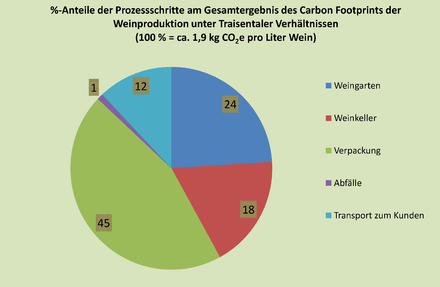
In a project in the Traisental , the process chain was analyzed and, on the basis of the results, those areas were identified that had the greatest influence on the CO 2 footprint. 1 liter of wine was defined as the functional unit. The investigation comprised the process steps of vineyard, wine production, packaging, waste and distribution. In the course of grape production in the vineyard, wine production in the cellar including waste and the bottling of an average wine, around 1.7 kg of CO 2 are emitted by the time it leaves the wine cellar . Around 0.2 kg of CO 2 per liter are added for transport to the consumer .
The result of the overall analysis showed that an average of 2.4 t of CO 2 equivalents are emitted per hectare of vineyards . Of this amount, around three quarters come from indirect greenhouse gas emissions and combustion emissions, and a quarter from soil emissions.
Measures to reduce
The greatest savings opportunities in the vineyard are in fuel consumption and the use of nitrogen and mineral fertilizers.
- Soil-conserving tillage by minimizing the number of mechanical tillage operations to increase the carbon sink function of the vineyard soils
- Use of organic fertilizers and economical use of mineral nitrogen fertilizers to improve the greenhouse gas balance of the soil
- Use of plant protection warning models to optimize the use of plant protection products to improve the effectiveness of the measures.
Savings are only possible in exceptional cases.
In the basement, packaging accounts for the largest share of total emissions. The production of the glass bottle has an overwhelming share, despite the high proportion of recycling in Austria. Alternative wine packaging is to be rated much better in this regard, such as B .: bag-in-box .
Cross compliance
Cross compliance regulations must be observed for all production methods .
“The rules of cross compliance (translated as“ cross compliance with obligations ”) are also referred to in German-speaking countries as“ other obligations ”and mean the link between premium payments and compliance with environmental standards (in the broader sense). Cross compliance has been used increasingly in agricultural policy practice in many industrialized countries since the mid-1980s, with compliance with the standards being a prerequisite for receiving the premium payments (but not the actual funding content for the payments). "
Training opportunities for viticulture and cellar management
The training opportunities in viticulture and cellar management can take place in the listed German-speaking countries in agricultural technical schools (viticulture schools), technical secondary schools, technical colleges and universities.
Germany
- Baden-Württemberg
- University of Hohenheim
- Heilbronn University
- State teaching and research institute for viticulture and fruit growing in Weinsberg
- Bavaria
- Hesse
- Geisenheim University together with the Geisenheim Research Institute
- Rhineland-Palatinate
- Apprenticeship in viticulture at the service center for the rural region of the Rhine Palatinate, Mußbach - Neustadt an der Weinstrasse
- DLR Rural Service Center
- University of Applied Sciences - Viticulture
- German Wine Academy
Switzerland
- Viticulture department at the University of Wädenswil
- École d'ingénieurs de Changins specializing in oenology
Austria
- Vienna
- University of Natural Resources and Life Sciences , studies in viticulture, oenology and wine management
- Lower Austria
- Higher federal college and federal office for viticulture and fruit growing
- Viticulture School and Wine Management Krems
- Agricultural college and AGRO-HAK Mistelbach
- Agricultural college in Hollabrunn
- Burgenland
- University of Applied Sciences Burgenland
- Fachschule Eisenstadt
- Master of Wine
- Wine Academy Austria in Rust and branch in Krems an der Donau
- Styria
- Silberberg viticulture school
Italy
- South-Tirol
- Technical school for fruit growing, viticulture and horticulture Laimburg
- Subject high school for agriculture in Auer
See also
- International Wine Office = International Organization for Vine and Wine
- International working group for soil cultivation and quality management in viticulture
- Word atlas of continental Germanic winemaker terminology
- Wine language
- Viticulture online
literature
Viticulture in general
- Karl Bauer, Ferdinand Regner , Barbara Friedrich: Viticulture. 12th updated edition. avBook, Vienna 2018, ISBN 978-3-8404-8503-9 .
- Edgar Müller, Hans-Peter Lipps, Oswald Walg: Viticulture. 3. Edition. Eugen Ulmer, 2008, ISBN 978-3-8001-1241-8 .
- Oswald Walg: Pocket book of viticulture technology. 2nd Edition. Fachverlag Fraund, 2007, ISBN 978-3-921156-78-0 .
- Karl Bauer, Rudolf Fox, Bernd Ziegler: Modern soil care in viticulture. Eugen Ulmer and Österreichischer Agrarverlag, 2004, ISBN 3-7040-2009-5 , D ISBN 3-8001-4608-8 .
- Dieter Hoppmann: Terroir, Weather - Climate - Soil. Verlag Ulmer, Stuttgart 2010, ISBN 978-3-8001-5317-6 .
Grape varieties
- Hans Ambrosi , Bernd HE Hill, Erika Maul, First H. Rühl, Joachim Schmid, Fritz Schuhmann: Color Atlas of Grape Varieties. 3. Edition. Eugen Ulmer, 2011, ISBN 978-3-8001-5957-4 .
Diseases, pests, beneficial insects
- Horst Diedrich Mohr: color atlas diseases, pests and beneficial insects on the grapevine . Eugen Ulmer, 2005, ISBN 3-8001-4148-5 .
- Helga Reisenzein, Friedrich Polesny, Erhard Höbaus: Diseases, pests and beneficial insects in viticulture. 5th edition. Österreichischer Agrarverlag, Vienna 2008, ISBN 978-3-7040-2319-3 .
- Blümel, Fischer-Colbrie, Höbaus: beneficial insects . Österreichischer Agrarverlag, Vienna 2006, ISBN 3-7040-2182-2 .
Organic viticulture
- Ilse Maier: Practical book organic viticulture . Österreichischer Agrarverlag, Vienna 2005, ISBN 3-7040-2090-7 .
- Uwe Hofmann, Paulin Köpfer, Arndt Werner: ecological viticulture . Eugen Ulmer, 1995, ISBN 3-8001-5712-8 .
Viticultural Lexica
- Jancis Robinson : The Oxford Wine Lexicon. 3. Edition. Hallwag, 2006, ISBN 3-8338-0691-5 .
- Dictionary of German winegrowers' language
Web links
- Diseases, pests and other damage in viticulture
- Website of the intern. Working group for soil cultivation and quality management in viticulture
- Biological WB, biodynamic viticulture and integrated viticulture in comparison
Viticultural associations, organizations, marketing
- Austrian Viticulture Association
- Austrian Wine Market Association - ÖWM
- German Viticulture Association
- German Wine Institute
- Association of German-Swiss Wine
- South Tyrolean wine
- Independent winegrowers in South Tyrol
Trade journals
- German viticulture
- The wine industry
- Vine & Wine
- The Baden winegrower
- The winemaker , the winemaker
- Communications Klosterneuburg
- Viticulture
- Fruit wine garden
- Swiss magazine for fruit and viticulture
- Fruit growing and viticulture - South Tyrolean advisory service
Databases, research
- Rolf Blaich: Biology of the Vine - Morphology of the Vine Lecture: Online
- Vitis - International Variety Catalog - VIVC
- GENRES - Information System Genetic Resources
- German database for vines
- Literature database
- Literature database on the history of wine d. Society of the History of Wine
- Swiss research for agriculture, food and the environment
Individual evidence
- ↑ situation of the global wine sector in 2007, OIV report.
- ↑ a b http% 3A% 2F% 2Fwww.oiv.int% 2Fpublic% 2Fmedias% 2F6782% 2Foiv-2019-statistical-report-on-world-vitiviniculture.pdf & usg = AOvVaw12qJ-Xp8d-2zTDxx9cnQ2K 2019 Statistical Report on World Vitiviniculture
- ↑ Impairment of world trade due to the low availability of wine ( memento of July 23, 2015 in the Internet Archive ), on the occasion of the “36. World Vine and Wine Congress ”in Bucharest, Romania
- ↑ Situation of the global viticulture sector in 2013 ( Memento from June 5, 2015 in the Internet Archive )
- ↑ Vineyard statistics 2019, Federal Statistical Office
- ^ European Vitis Database
- ↑ Information portal of the Rebveredlung Antes www.Traubenshow.de ( Memento from September 6, 2009 in the Internet Archive )
- ^ Klosterneuburg ( Memento from March 22, 2009 in the Internet Archive )
- ↑ Agroscope research area crop protection, arable farming and viticulture-oenology ( Memento from January 2, 2017 in the Internet Archive )
- ^ Karl Bauer, Ferdinand Regner , Barbara Schildberger: Viticulture. 9th edition. avBook published by Cadmos Verlag, Vienna 2013, ISBN 978-3-7040-2284-4 , p. 171.
- ^ Karl Bauer, Ferdinand Regner , Barbara Schildberger: Viticulture. 9th edition. avBook published by Cadmos Verlag, Vienna 2013, ISBN 978-3-7040-2284-4 , p. 212.
- ↑ B. Prior: Oppenheimer grape brush (OTB) - A new method for mechanical yield reduction in viticulture. DLR RheinhessenöNahme-Hunsrück, Südtiroler Obstbau Weinbau, 4/2011, pp. 126–129 (PDF) ( Memento from September 24, 2015 in the Internet Archive )
- ↑ Guidelines for appropriate fertilization in viticulture, 1st edition 2003, AGES Institute for Soil Management, Vienna. ( Memento from June 8, 2009 in the Internet Archive )
- ↑ Rudolf Heitefuss: Plant protection. Basics of practical phytomedicine . Thieme-Verlag, Stuttgart 2000, 3rd edition, ISBN 978-3-13-513303-4 .
- ^ Karl Bauer, Ferdinand Regner , Barbara Schildberger: Viticulture. 9th edition. avBook published by Cadmos Verlag, Vienna 2013, ISBN 978-3-7040-2284-4 , p. 318.
- ↑ Plant protection recommendations for viticulture 2013/2014, including the brochure "Recommended Plant Protection Products", Switzerland ( Memento from May 18, 2015 in the Internet Archive )
- ^ Karl Bauer, Ferdinand Regner , Barbara Schildberger: Viticulture. 9th edition. avBook published by Cadmos Verlag, Vienna 2013, ISBN 978-3-7040-2284-4 , p. 314.
- ↑ Guideline for appropriate fertilization in viticulture ( Memento of June 8, 2009 in the Internet Archive ) 1st edition 2003, AGES Institute for Soil Management, Vienna
- ↑ PDF Recognizing nutrient deficiency diseases and excesses , Monika Riedel, Badischer Winzer 3/2005
- ^ A b c Karl Bauer, Ferdinand Regner , Barbara Schildberger: Viticulture. 9th edition. avBook published by Cadmos Verlag, Vienna 2013, ISBN 978-3-7040-2284-4 .
- ^ Karl Bauer, Ferdinand Regner , Barbara Schildberger: Viticulture. 9th edition. avBook published by Cadmos Verlag, Vienna 2013, ISBN 978-3-7040-2284-4 , p. 406.
- ↑ Guidelines: → Demeter Austria
- ↑ Peter Treue: Blood and Beans: The paradigm shift in the Künast Ministry replaces science with occultism. In: The present. Frankfurter Allgemeine Zeitung, March 13, 2002, archived from the original on April 17, 2003 ; Retrieved November 15, 2011 .
- ↑ Holger Kirchmann: Biological dynamic farming - an occult form of alternative agriculture? In: J. Agric. Environ. Ethics . tape 7 , no. 2 , 1994, p. 173-187 , doi : 10.1007 / BF02349036 .
- ↑ Odile T. Bruggisser, Martin H. Schmidt-Entling, Sven Bacher: Study by the University of Neuchâtel and Friborg . Biological Conservation 2010. (online version)
- ↑ A. Freund, J. Harnecker, R. Kauer, A. Reineke: Species diversity (arthropods) in the vineyard: What influence does the type of cultivation and the greening have? German Viticulture Yearbook 2011, Verlag Ulmer, Stuttgart, ISBN 978-3-8001-6983-2 , pp. 157-164
- ↑ Definition: Sustainability, article in the online administration lexicon olev.de, Version 1.71r www.olev.de
- ↑ Josef Glatt: Project “Sustainably Produced Austrian Wine”, The Austrian Sustainability Portal, BLFUW
- ↑ a b Eva Burger, Ines Omann: WEINKLIM Carbon Footprint Analysis for Wine. Traisental 2010 [1] (PDF)
- ↑ Gerhard Soja, Franz Zehetner, Gorana Rampazzo-Todorovic, Barbara Schildberger, Konrad Hackl, Rudolf Hofmann, Eva Burger, Sigrid Grünberger, Ines Omann Viticulture in Climate Change: Adaptation and Mitigation Options Using the Example of the Traisental Model Region [2] (PDF)
- ^ State teaching and research institute for viticulture and fruit growing in Weinsberg
- ↑ Viticulture training
- ^ Service center for rural areas Rheinhessen-Nahe-Hunsrück ( Memento from June 11, 2009 in the Internet Archive )
- ↑ Ludwigshafen am Rhein University of Applied Sciences ( Memento from May 9, 2010 in the Internet Archive )
- ↑ Weinbau.ch
- ↑ Eichangins.ch ( Memento from November 9, 2013 in the Internet Archive )
- ^ University of Natural Resources and Life Sciences, Vienna
- ^ Bundeslehranstalt Klosterneuburg ( Memento from April 12, 2015 in the Internet Archive )
- ↑ Weinbauschule Krems, VINOHAK, Wine Management Krems
- ↑ Agricultural college and AGRO-HAK Mistelbach
- ↑ Hollabrunn Agricultural College
- ↑ University of Applied Sciences Burgenland
- ↑ Technical College Eisenstadt
- ↑ Wine Academy Austria ( Memento from June 10, 2009 in the Internet Archive )
- ^ Technical college Silberberg near Leibnitz
- ^ Technical college for fruit, wine and horticulture in Laimburg
- ^ High school for agriculture, Auer
